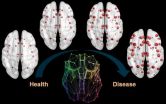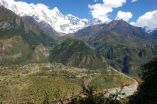Epidemic spreading and neurodegenerative progression
2014-11-20
(Press-News.org) Researchers from the Montreal Neurological Institute have used a model inspired by patterns of epidemic disease spreading to map how misfolded proteins propagate within the brain.
Proteins which fail to configure correctly (misfolded proteins) are associated with aging and several human neurodegenerative diseases, such as Alzheimer's. In research published in this week's PLOS Computational Biology, Yasser Iturria Medina and colleagues analyze over 700 individual Amyloid-beta proteins imaging datasets to conclude that the propagation of these misfolded proteins, associated with Alzheimer's disease progression, can be mathematically described by the interaction between infection-like agents (the misfolded proteins) and the brain's defense response.
The authors' model relies on the striking similarity between intra-brain pathology propagation processes and the spread of human infectious diseases. They demonstrate that the brain's connections between cells play a similar role in misfolded protein dynamics as global air-traffic routes play for the international spreading of diseases such as the 2009 H1N1 pandemic. The researchers also identified genetic and demographic factors that influence this phenomenon in healthy aging and Alzheimer's disease progression.
The authors said: "The epidemic spreading theory constitutes a general framework for intra-brain region-to-region transference mechanisms in health and disease. Our next goal is to uncover how other pathologic factors, such as vascular dysregulation, interact with misfolded protein propagation in causing dementia. Identifying aberrant individual clearance levels as a major factor in Amyloid-beta proteins accumulation, as opposed to increased production levels, could imply a turning point for the development of therapeutic strategies in Alzheimer's disease."
INFORMATION:
Image Caption: The human brain´s structural connectome (below, center) modulates the propagation of toxic Amyloid-beta proteins, from non-binding (above, left) to advanced deposition patterns (above, right) associated with healthy and diseased brain states respectively. In the Amyloid-beta deposition images (above, from left to right) node sizes are proportional to the associated Amyloid-beta burden.
Image Credit: Iturria-Medina et al.
Image Link: http://www.plos.org/wp-content/uploads/2014/11/20-Nov-Medina.tif
All works published in PLOS Computational Biology are Open Access, which means that all content is immediately and freely available. Use this URL in your coverage to provide readers access to the paper upon publication: http://www.ploscompbiol.org/article/info:doi/10.1371/journal.pcbi.1003956
Contact: Yasser Iturria-Medina & Dr. Alan C. Evans
Address: Montreal,
Quebec H3A 2B4
CANADA
Phone: 15143986447 & 15143988926
Email: iturria.medina@gmail.com & alan@bic.mni.mcgill.ca
Citation: Iturria-Medina Y, Sotero RC, Toussaint PJ, Evans AC, the Alzheimer's Disease Neuroimaging Initiative (2014) Epidemic Spreading Model to Characterize Misfolded Proteins Propagation in Aging and Associated Neurodegenerative Disorders. PLoS Comput Biol 10(11): e1003956. doi:10.1371/journal.pcbi.1003956
Funding: Data collection and sharing for this project was funded by the Alzheimer's Disease Neuroimaging Initiative (ADNI) (National Institutes of Health Grant U01 AG024904) and DOD ADNI (Department of Defense award number W81XWH-12-2-0012). ADNI is funded by the National Institute on Aging, the National Institute of Biomedical Imaging and Bioengineering, and through generous contributions from the following: Alzheimer's Association; Alzheimer's Drug Discovery Foundation; BioClinica, Inc.; Biogen Idec Inc.; Bristol-Myers Squibb Company; Eisai Inc.; Elan Pharmaceuticals, Inc.; Eli Lilly and Company; F. Hoffmann-La Roche Ltd and its affiliated company Genentech, Inc.; GE Healthcare; Innogenetics, N.V.; IXICO Ltd.; Janssen Alzheimer Immunotherapy Research & Development, LLC.; Johnson & Johnson Pharmaceutical Research & Development LLC.; Medpace, Inc.; Merck & Co., Inc.; Meso Scale Diagnostics, LLC.; NeuroRx Research; Novartis Pharmaceuticals Corporation; Pfizer Inc.; Piramal Imaging; Servier; Synarc Inc.; and Takeda Pharmaceutical Company. The Canadian Institutes of Health Research is
providing funds to support ADNI clinical sites in Canada. Private sector contributions are facilitated by the Foundation for the National Institutes of Health. The grantee organization is the Northern California Institute for Research and Education, and the study is coordinated by the Alzheimer's Disease Cooperative Study at the University of California, San Diego. ADNI data are disseminated by the Laboratory for Neuro Imaging at the University of Southern California. Data used in preparation of this article were obtained from the Alzheimer's Disease Neuroimaging Initiative (ADNI) database (adni.loni.usc.edu). As such, the investigators within the ADNI contributed to the design and implementation of ADNI and/or provided data but did not participate in analysis or writing of this report. The funders had no role in study design, data collection and analysis, decision to publish, or preparation of the manuscript.
Competing Interests: The authors have declared that no competing interests exist.
About PLOS Computational Biology
PLOS Computational Biology features works of exceptional significance that further our understanding of living systems at all scales through the application of computational methods. All works published in PLOS Computational Biology are Open Access. All content is immediately available and subject only to the condition that the original authorship and source are properly attributed. Copyright is retained. For more information follow @PLOSCompBiol on Twitter or contact ploscompbiol@plos.org.
About PLOS
PLOS is a nonprofit publisher and advocacy organization founded to accelerate progress in science and medicine by leading a transformation in research communication. For more information, visit http://www.plos.org.
[Attachments] See images for this press release:

ELSE PRESS RELEASES FROM THIS DATE:
2014-11-20
An international team of researchers has shown that it may be possible to improve the effectiveness of the seasonal flu vaccine by 'pre-empting' the evolution of the influenza virus.
In a study published today in the journal Science, the researchers, led by the University of Cambridge, describe how an immunological phenomenon they refer to as a 'back boost' suggests that it may be better to pre-emptively vaccinate against likely future strains than to use a strain already circulating in the human population.
Influenza is a notoriously difficult virus against which to ...
2014-11-20
RIVERSIDE, Calif. - Yellow fever is a disease that can result in symptoms ranging from fever to severe liver damage. Found in South America and sub-Saharan Africa, each year the disease results in 200,000 new cases and kills 30,000 people. About 900 million people are at risk of contracting the disease.
Now a research team led by a biomedical scientist at the University of California, Riverside has determined that the yellow fever virus, a hemorrhagic fever virus, replicates primarily in the liver. Therefore, other organ failures that often follow in people with the ...
2014-11-20
During the development of mammals, the growth and organization of digits are orchestrated by Hox genes, which are activated very early in precise regions of the embryo. These "architect genes" are themselves regulated by a large piece of adjacent DNA. A study led by Denis Duboule, professor at the University of Geneva (UNIGE) and the Federal Institute of Technology in Lausanne (EPFL), Switzerland, reveals that this same DNA regulatory sequence also controls the architect genes during the development of the external genitals. The results published in Science magazine, indicate ...
2014-11-20
If you are an active senior who wants to stay younger, keep on running.
A new study involving the University of Colorado Boulder and Humboldt State University shows that senior citizens who run several times a week for exercise expend about the same amount of energy walking as a typical 20-year-old.
But older people who walk for exercise rather than jog expend about the same amount of energy walking as older, sedentary adults, and expend up to 22 percent more energy walking than the 20-something crowd. The study, led by Humboldt State Professor Justus Ortega, was published ...
2014-11-20
Animal teeth, bones and plant remains have helped researchers from Cambridge, China and America to pinpoint a date for what could be the earliest sustained human habitation at high altitude.
Archaeological discoveries from the 'roof of the world' on the Tibetan Plateau indicate that from 3,600 years ago, crop growing and the raising of livestock was taking place year-round at hitherto unprecedented altitudes.
The findings, published today in Science, demonstrate that across 53 archaeological sites spanning 800 miles, there is evidence of sustained farming and human ...
2014-11-20
China's second great wall, a vast seawall covering more than half of the country's mainland coastline, is a foundation for financial gain - and also a dyke holding a swelling rush of ecological woes.
A group of international sustainability scholars, including Jianguo "Jack" Liu, director of Michigan State University's Center for Systems Integration and Sustainability, in a paper published today in Science magazine, outline the sweeping downsides of one of China's efforts to fuel its booming economy, downsides that extend beyond China.
China's coastal regions are only ...
2014-11-20
The Himalaya features some of the most impressive gorges on Earth that have been formed by rivers. The geologic history of the famous Tsangpo Gorge, in the eastern Himalaya, now needs to be rewritten.
A team of German, Chinese, and American geoscientists have namely discovered a canyon, filled with more than 500 m of sediments beneath the bed of the present-day Yarlung Tsangpo River upstream from the gorge. Using drill cores, the scientists were able to reconstruct the former valley floor of this river, which allowed them to reconstruct the geological history of the Tsangpo ...
2014-11-20
Doctors have long been mystified as to why HIV-1 rapidly sickens some individuals, while in others the virus has difficulties gaining a foothold. Now, a study of genetic variation in HIV-1 and in the cells it infects reported by University of Minnesota researchers in this week's issue of PLOS Genetics has uncovered a chink in HIV-1's armor that may, at least in part, explain the puzzling difference -- and potentially open the door to new treatments.
HIV-1 harms people by invading immune system cells known as T lymphocytes, hijacking their molecular machinery to make more ...
2014-11-20
A team of researchers from Caltech and the China Earthquake Administration has discovered an ancient, deep canyon buried along the Yarlung Tsangpo River in south Tibet, north of the eastern end of the Himalayas. The geologists say that the ancient canyon--thousands of feet deep in places--effectively rules out a popular model used to explain how the massive and picturesque gorges of the Himalayas became so steep, so fast.
"I was extremely surprised when my colleagues, Jing Liu-Zeng and Dirk Scherler, showed me the evidence for this canyon in southern Tibet," says Jean-Philippe ...
2014-11-20
Bangkok (Thailand)- A recent study from the Thai-Myanmar border highlights the severe and previously under-reported adverse impact of readily treatable tropical rickettsial illnesses, notably scrub typhus and murine typhus, on pregnancy outcomes, finding that more than one third of affected pregnancies resulted either in stillbirth or premature and/or low birth weight babies.
Conducted by Prof Rose McGready and Assoc. Prof Daniel Henry Paris from the Shoklo Malaria Research Unit (SMRU) in Mae Sot, Thailand, and the Mahidol Oxford Research Unit (MORU) in Bangkok, affiliated ...
LAST 30 PRESS RELEASES:
[Press-News.org] Epidemic spreading and neurodegenerative progression





